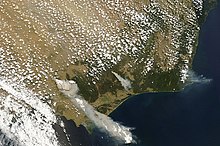Black Saturday fires
| Black Saturday bushfires | |
|---|---|

MODIS Aqua satellite image of smoke plumes and a pyrocumulus cloud northeast of Melbourne during the morning of 7 February 2009.
|
|
| Location | Victoria, Australia |
| Statistics | |
| Date(s) | 7 February 2009-14 March 2009 |
| Burned area | 450,000 hectares (1,100,000 acres) |
| Cause | Various confirmed sources including: Power lines Arson Lightning Machinery |
| Land use | Urban/Rural Fringe Areas, Farmland, and Forest Reserves/National Parks |
| Buildings destroyed |
3,500+ (2,029 houses) |
| Fatalities | 173 |
| Injuries | 414 |
The Black Saturday bushfires were a series of bushfires that ignited or were burning across the Australian state of Victoria on and around Saturday, 7 February 2009 and were Australia's all-time worst bushfire disasters. The fires occurred during extreme bushfire-weather conditions and resulted in Australia's highest ever loss of life from a bushfire; 173 people died and 414 were injured as a result of the fires.
As many as 400 individual fires were recorded on 7 February. Following the events of 7 February 2009 and its aftermath, that day has become widely referred to in Australia as Black Saturday.
A week before the fires, an exceptional heatwave affected southeastern Australia. From 28–30 January, Melbourne broke records by sweltering through three consecutive days above 43 °C (109 °F), with the temperature peaking at 45.1 °C (113.2 °F) on 30 January, the third hottest day in the city's history.
The heatwave was caused by a slow moving high-pressure system that settled over the Tasman Sea, with a combination of an intense tropical low located off the North West Australian coast and a monsoon trough over northern Australia, which produced ideal conditions for hot tropical air to be directed down over southeastern Australia.
The February fires commenced on a day when several localities across the state, including Melbourne, recorded their highest temperatures since records began in 1859. On 6 February 2009—the day before the fires started—the Premier of Victoria John Brumby issued a warning about the extreme weather conditions expected on 7 February: "It's just as bad a day as you can imagine and on top of that the state is just tinder-dry. People need to exercise real common sense tomorrow". The Premier went on to state that it was expected to be the "worst day [of fires conditions] in the history of the state".
...
Wikipedia
